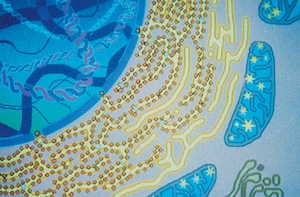866-295-4143, fbns@wayoflife.org

All plant life, animal tissues and organs are composed of cells. This began to be discovered in the 1830s, but man’s knowledge of cellular life has exploded since the latter half of the 20th century.
In Darwin’s day, it was thought that the cell was a very simple thing. Ernst Haeckel called it “a simple little lump of albuminous combination of carbon” (Haeckel, The History of Creation, 1868).
Haeckel was wrong, and the very complexity of the living cell has convinced many scientists that life could not have evolved.
“I believe in a Creator because I see the Creator’s designs in nature everywhere and evidence of intelligence in the DNA of each cell” (John Kramer, Ph.D. in biochemistry, In Six Days, edited by John Ashton, p. 54).
“Though I once embraced the evolutionary paradigm, its inadequate explanations for the origin of life coupled with the sophistication and complexity of the cell’s chemical systems convinced me as a biochemistry graduate student that a Creator must exist” (Fazale Rana, Ph.D. in chemistry, The Cell’s Design, p. 17).
“Complexity of the cell is now just too daunting to flippantly assert biochemical evolution to explain it, unless you close your mind and press on blindly and boldly. It has now become quite a feat to think about cells originating through biochemical evolution. And if cells could not originate naturally, then nothing else could” (Henry Zuill, Ph.D. in biology, In Six Days, edited by John Ashton, p. 68).
The living cell is a fantastically complex thing, more complex than a modern city. It’s a living body with organs called organelles. It has blueprints, decoders, error checkers, quality control systems, power plants (mitochondria), power storage units, manufacturing plants (cytoplasm, endoplasmic reticulum, Golgi apparatus), chemical plants, assembly lines, disposal units (proteasome), trash compactors, a complex communication system, recycling centers (lysosomes), detoxification plants (peroxisomes), transportation highways and tracks and tunnels, transportation vehicles (dynein), living walls with many types of one-
way and two-way guarded, gated portals to the outside world, an external matrix to connect with other cells, and a host of other things. It is living and reproducing and not only makes its own machinery but also its own raw materials.
Michael Denton describes the complexity of the cell as follows:
“To grasp the reality of life as it has been revealed by molecular biology, we must magnify a cell a thousand million times until it is twenty kilometres in diameter and resembles a giant airship large enough to cover a great city like London or New York. What we would then see would be an object of unparalleled complexity and adaptive design. On the surface of the cell we would see millions of openings, like the port holes of a vast space ship, opening and closing to allow a continual stream of materials to flow in and out. If we were to enter one of these openings we would find ourselves in a world of supreme technology and bewildering complexity.
We would see endless highly organized corridors and conduits branching in every direction away from the perimeter of the cell, some leading to the central memory bank in the nucleus and others to assembly plants and processing units.
The nucleus itself would be a vast spherical chamber more than a kilometre in diameter, resembling a geodesic dome inside of which we would see, all neatly stacked together in ordered arrays, the miles of coiled chains of the DNA molecules. A huge range of products and raw materials would shuttle along all the manifold conduits in a highly ordered fashion to and from all the various assembly plants in the outer regions of the cell. ...
“We would see around us, in every direction we looked, all sorts of robot-like machines. We would notice that the simplest of the functional components of the cell, the protein molecules, were astonishingly, complex pieces of molecular machinery, each one consisting of about three thousand atoms arranged in highly organized 3-D spatial conformation. We would wonder even more as we watched the strangely purposeful activities of these weird molecular machines, particularly when we realized that, despite all our accumulated knowledge of physics and chemistry, the task of designing one such molecular machine--that is one single functional protein molecule--would be completely beyond our capacity at present and will probably not be achieved until at least the beginning of the next century. ...
“We would see that nearly every feature of our own advanced machines had its analogue in the cell: artificial languages and their decoding systems, memory banks for information storage and retrieval, elegant control systems regulating the automated assembly of parts and components, error fail-safe and proof-reading devices utilized for quality control, assembly processes involving the principle of prefabrication and modular construction. In fact, so deep would be the feeling of deja-vu, so persuasive the analogy, that much of the terminology we would use to describe this fascinating molecular reality would be borrowed from the world of late twentieth-century technology” (Evolution: A Theory in Crisis, 1986, pp. 328, 329).
The cell contains not only the blueprint of the plant or animal’s body and the information describing its every function but also the ability to actually fashion and operate it.
A typical cell contains more than a trillion parts at the atomic level (Jerry Bergman, Ph.D. biology, In Six Days, edited by John Ashton, p. 25)
Even a “simple” E. coli bacterium has about 4,640,000 nucleotide base pairs, which code for 4,288 genes, each one of which produces an enormously complex protein machine (Bergman, p. 25)
There are 200 major types of cells in the human body and each one contains the complete DNA needed to create the entire body. Each cell uses only that part of the DNA instructions necessary to accomplish its particular function.
The information in the DNA in one human cell is equivalent to a library of 4,000 books (each containing 500 pages), yet all of the DNA from every person who has ever lived would weigh less than an aspirin tablet (Walt Brown, In the Beginning).
If the information contained in all of the cells of the human body were reduced to books, they would fill the 800 cubic miles of the Grand Canyon 98 times (Brown, p. 75).
“A live reading of the DNA in one cell at a rate of one letter per second would take thirty-one years, even if reading continued day and night. Printing these letters out in regular font size on normal bond paper and binding them all together would result in a tower the height of the Washington Monument” (Francis Collins, The Language of God).
The amount of information that could be stored in a pinhead’s volume of DNA is equivalent to a pile of paperback books 500 times as tall as the distance from earth to the moon, each with a different, yet specific, content (W. Gitt, “Dazzling Design in Miniature,” Creation Ex Nihilo, Dec. 1997 - Feb. 1998, p. 6).
One gram of DNA can house as much information as nearly one trillion CDs (Fazale Rana, The Cell’s Design, p. 164).
There are 60 trillion cells in the human body.
ATP is necessary for life
The living cell is powered by ATP (Adenosine TriPhosphate), which is produced in the cell’s mitochondria by an amazing genetic motor called ATP Synthase. Without ATP there would be no biological life and without the ATP motor there would be no ATP. One trillion trillion of these complex motors would fit on the head of a pin. They typically spin at about 10,000 rpm and develop immense torque, with each rotation producing three ATP molecules.
“The human body generates about its own weight of ATP every day, generated by trillions of these motors. And it is consumed very quickly to power vital biochemical reactions, including DNA and protein synthesis, muscle contraction, transport of nutrients and nerve impulses. An organism without ATP is like a car without gasoline. Cyanide is so toxic precisely because it stops ATP production. ... because energy is vital for life, life could not have evolved before this motor was fully functional.
This is an even more foundational problem: natural selection by definition is differential reproduction, so requires self-reproducing entities at the start. Yet self-reproduction requires ATP to supply the energy! So does the expression of the information that is selected. So even if a series of gradual steps could be imagined up this peak of ‘Mount Improbable,’ there would be no natural selection to enable that climb. This is because all the hypothetical intermediates would be lacking energy and thus dead” (Jonathan Sarfati, By Design, pp. 135, 136).
Shem Dharampaul, M.D., observes: “In the glycolytic pathway which produces ATP, you need to input two molecules of ATP to produce four molecules of ATP (net product of two molecules). It is a classic chicken and egg scenario. From where did the first two molecules appear?”
Cells are largely made up of proteins (about a million per cell in thousands of varieties), and cells and proteins in turn form the body. Proteins “are the machines within living tissue that build the structures and carry out the chemical reactions necessary for life” (Michael Behe, Darwin’s Black Box).
Muscles, skin, hair, eyes, antibodies, enzymes (that produce essential chemical reactions such as breaking down sugar), and hormones are made of proteins. Blood clotting is accomplished by the proteins fibrinogen and thrombin. Hemoglobin in the red blood cell is a protein that allows oxygen to be transported to every part of the body. The proteins collagen and keratin, which are elastic and stronger than steel, make up skin, hair, and fingernails, as well as the structural support within the cell itself.
The cell can make thousands of different types of proteins, each one amazingly complex in itself and designed for a specific function. For example, there are hundreds of types of proteins that bridge the cell membrane to act as gates and transporters.
First the DNA (deoxyribonucleic acid) makes three kinds of RNA (ribonucleic acid). The RNA then reads the DNA’s complicated code, knowing exactly where to start and how to accomplish this task, working with the cell’s various organs to create proteins according to the master blueprint. This process is complex beyond words, and scientists are only beginning to understand small parts of it.
Each protein is composed of a long string of 20 different amino acids, typically thousands in length, and each amino acid must be in exactly the right sequence for the protein to work. After the protein is strung together, it is folded and shaped perfectly within the cell’s factories and then transported to the right place. The right shaping is essential.
Proteins require DNA for formation, but DNA is itself made up of proteins.
“Because DNA and proteins depend so intimately on each other for their survival, it’s hard to imagine one of them having evolved first. But it’s just as implausible for them to have emerged simultaneously out of a prebiotic soup” (Carl Zimmer, “How and Where Did Life on Earth Arise?” Science, Vol. 309, July 1, 2005, p. 89).
“A quick summation will reveal that the process of converting DNA information into proteins requires at least 75 different protein molecules. But each and every one of these 75 proteins must be synthesized in the first place by the process in which they themselves are involved. How could the process begin without the presence of all the necessary proteins? ... without proteins life would not exist; it is as simple as that.
The same is true of DNA and RNA. It should be clear that DNA, RNA, and proteins must all be present if any of them are going to be present in a living organism. Life must have been created completely functional, or it would be a meaningless mess. To suggest otherwise is plain ignorance (or perhaps desperation). So, we truly have a ‘which came first?’ problem on our hands. I believe the answer is, of course, that none of them came first! God came first; He designed and then created all of life with His spoken Word. DNA, RNA, and protein came all at exactly the same time.
It is extremely difficult to understand how anyone could believe that this astoundingly complicated DNA-blueprint translation system happened to come about by chance” (John Marcus, Ph.D. in biological chemistry from the University of Michigan, In Six Days, edited by John Ashton, p. 177).
Enzymes are necessary for life
The cell also requires the activity of proteins called enzymes, which are catalysts that facilitate and speed up chemical reactions.
Michael Pitman, who taught biology at Cambridge, writes:
“‘Living matter’, comments leading enzymologist M. Dixon, ‘is the most wonderful chemical system in the world.’ Part of its ‘magic’ is that it consists of a complex network of chemical reactions and processes, arranged so that the product of each reaction is the starting material of the next link in the chain. All such reactions are brought about by enzymes, of which there are many thousands. These are special proteins, each with the power of causing specific chemical reactions that would not occur in their absence. Dixon likens enzymes to automated machine tools, each of which performs one particular operation on a product and hands it on to the next. Some production lines join up, giving rise to a network of lines with many pathways--a network called metabolism. ...
“Dixon confesses that he cannot see how such a system could ever have originated spontaneously. The main difficulty is that an enzyme system does not work at all until it is complete, or nearly so. Another problem is the question of how enzymes appear without pre-existing enzymes to make them. ‘The association between enzymes and life’, Dixon writes, ‘is so intimate that the problem of the origin of life itself is largely that of the origin of enzymes.’ ...
“Certain basic pathways are common to all living systems and must have been present since life began. The glycolytic pathway in which sugar is broken down, releasing energy, is one example; respiration and many other functions basic to life also depend upon networks of metabolic pathways, usually involving dozens of complex stages, which are recognizable throughout the plant and animal kingdoms.
“Enzyme systems are doing every minute what battalions of full-time chemists cannot. The mechanisms of their actions are only just beginning to be understood and we cannot yet manipulate them with any confidence. The idea of designing enzymes for specific purposes, then synthesizing them, is futuristic. This may come: if it does it will be the product of very concentrated thought and manipulative skill by teams of dedicated scientists. Can anyone seriously imagine that naturally occurring enzymes realized themselves, along with hundreds of specific friends, by chance? Enzymes and enzyme systems, like the genetic mechanisms whence they originate, are masterpieces of sophistication” (Pitman, Adam and Evolution, pp. 144, 145).
Enzymes speed up living processes that would otherwise be impossible. The phosphatase enzyme, for example, catalyzes the hydrolysis or splitting of phosphate bonds, which are necessary for cellular life.
“This enzyme allows reactions vital for cell signaling and regulation to take place in a hundredth of a second. Without the enzyme, this essential reaction would take a trillion years--almost a hundred times even the supposed evolutionary age of the universe (about 15 billion years)” (Jonathan Sarfati, By Design, p. 157).
DNA editing machinery is necessary for life
The DNA copying and reading process has complex editing ability.
“The copying is far more precise than pure chemistry could manage--only about 1 mistake in 10 billion letters, because there is editing (proof-reading and error-checking) machinery, again encoded in the DNA. But how would the information for editing machinery be transmitted accurately before this machinery was in place? Lest it be argued that the accuracy could be achieved stepwise through selection, note that a high degree of accuracy is needed to prevent ‘error catastrophe’--the accumulation of ‘noise’ in the form of junk proteins. Again there is a vicious circle, a ‘Catch-22’ (more irreducible complexity)” (Sarfati, By Design, p. 163).
Chemical pathways and barriers are necessary for life
Walt Brown, Ph.D. in mechanical engineering from MIT, observes:
“Living cells contain thousands of different chemicals, some acidic, others basic. Many chemicals would react with others were it not for an intricate system of chemical barriers and buffers. If living things evolved, these barriers and buffers must also have evolved--but at just the right time to prevent harmful chemical reactions. How could such precise, seemingly coordinated, virtually miraculous events have happened for each of millions of species?” (In the Beginning, p. 15).
These are just a few of the terribly complex features of the living cell which point directly to an Almighty God.
- Receive these reports by email
- www.wayoflife.org
______________________
Sharing Policy: Much of our material is available for free, such as the hundreds of articles at the Way of Life web site. Other items we sell to help fund our expensive literature and foreign church planting ministries. Way of Life's content falls into two categories: sharable and non-sharable. Things that we encourage you to share include the audio sermons, O Timothy magazine, FBIS articles, and the free eVideos and free eBooks. You are welcome to make copies of these at your own expense and share them with friends and family. You may also post parts of reports and/or entire reports to websites, blogs, etc as long as you give proper credit (citation). A link to the original report is very much appreciated as the reports are frequently updated and/or expanded. Things we do not want copied and distributed are "Store" items like the Fundamental Baptist Digital Library, print editions of our books, electronic editions of the books that we sell, the videos that we sell, etc. The items have taken years to produce at enormous expense in time and money, and we use the income from sales to help fund the ministry. We trust that your Christian honesty will preserve the integrity of this policy. "For the scripture saith, Thou shalt not muzzle the ox that treadeth out the corn. And, The labourer is worthy of his reward" (1 Timothy 5:18). Questions? support@wayoflife.org
Goal:Distributed by Way of Life Literature Inc., the Fundamental Baptist Information Service is an e-mail posting for Bible-believing Christians. Established in 1974, Way of Life Literature is a fundamental Baptist preaching and publishing ministry based in Bethel Baptist Church, London, Ontario, of which Wilbert Unger is the founding Pastor. Brother Cloud lives in South Asia where he has been a church planting missionary since 1979. Our primary goal with the FBIS is to provide material to assist preachers in the edification and protection of the churches.
Offering: Offerings are welcome if you care to make one. If you have been helped and/or blessed by our material offerings can be mailed or made online with with Visa, Mastercard, Discover, or Paypal. For information see: www.wayoflife.org/about/makeanoffering.html.





